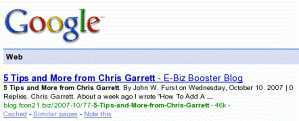Winning Titles And 8 Tips For More Traffic
 “More readers” is your ultimate goal for your Blog. The more readers you attract on a regular basis, the more your Blog will work for you. Whatever you want to get out of it, like money, influence on public opinion, etc. Follow some basic rules for writing on the Web and the same kind of information you provide will gain more popularity.
“More readers” is your ultimate goal for your Blog. The more readers you attract on a regular basis, the more your Blog will work for you. Whatever you want to get out of it, like money, influence on public opinion, etc. Follow some basic rules for writing on the Web and the same kind of information you provide will gain more popularity.Did you every write an article or a Blog post and many readers left a comment how great and valuable your info is. They say, they stumbled it, dugg it, bookmarked, printed it and put it on their board right in front of them. You feel flattered and think you have hit it this time.
Then later you look at your Web stats and recognize those readers were about the only ones that have read it. Sad story.
What went wrong? Most likely your title, your headline, sucks and probably your first paragraph, too.
To understand this you must realize how Web users find the way to your post. Your loyal readers, those who probably left the comments, have subscribed to your Blog's RSS feed, email announcement list or simply type in your URI and read whatever you write.
All the others, whose attention you wish to catch, only see a link to your site somewhere. Based on that link, they quickly decide: “Click or Not To Click”. How much they get to see depends on where they come across the link to your post. Here are a few examples.
- The Title and the Blog's name like with BlogRush (have a look in my sidebar).
- The title and some excerpt line on a Search Engine's Results Page (SERP). If you do your SEO homework right. The excerpt should be something like the first paragraph of your post or the content of the Meta Description Tag. That differs between search engines. But it is usually not much. Look at this example from Google. Doesn't say much, does it.
- Listening in a Blog Directory
- A totally different link text as used sometimes by bloggers to fit your link into their content. You don't have much control over that.
…
I guess you probably start to see that is all about “winning titles” and “hot topics”.
Here are my tips:
1. Write about “hot” topics. At least sometimes!
For example: My article about PageRank was more “successful” than the latter one about Customer Service. You heard about the Google Slap for sure (otherwise you likely would not read on my Blog).
The hot posts will get you additional readers, some will subscribe and also find value in the other posts of you that might not be as hot as considered by the masses.
2. Use winning titles!
Surf social bookmarking sites and see what kind of titles are popular in your “market” that you are writing about. Get a feeling for “wining titles” and “hot topics”. Of course the story must deliver on the title. The title should be the most condensed version of the article that gives a reason why someone should click that link and read the whole story.
- Technorati.com (↑)
- Digg.com (↑)
- StumbleUpon.com (↑)
- Del.icio.us" (↑)
- Leave a comment, if you want me to add your favorite platforms. Which is …?
3. Put most important words to the front
Recent usability research has revealed people often read only the first two words of a paragraph. They scan Web pages. That means it is important to get those first two words right in titles, headlines, subheads, summaries, captions, hypertext links, and bulleted lists.
Usability expert Jakob Nielsen (↑) derives two rules for winning articles:
- Don't use the same initial keywords in your headline and summary. You have 4 words to make your point, so use 4 different words. That is 2 words in the headline and 2 words in the summary, which should be your first paragraph.
- Avoid repeating any headline words in the summary, except for the most important one or two keywords. You can repeat these halfway through the summary to reinforce them for people who scanned past them in the headline.
In order to get the first two words right, you might need to use passive voice. This is a new exception to the general rule, that you should use active voice in your Web writing. For example:
- Active Voice: Yahoo Finance follows all 13 design guidelines for tab controls
- Passive Voice: 13 design guidelines for tab controls are all followed by Yahoo Finance
The second one gives the better title, because the article referred is not about Yahoo Finance. It is about the design guidelines and their impact on Yahoo Finance.
Jakob Nielsen explains that point wonderfully in his new article, Passive Voice Is Redeemed For Web Headings (↑). I recommend that your read the whole article.
This actually also corresponds with classic search engine optimization (SEO) technique to pull you most important keywords to the beginning of link text, titles and so forth. Again, another instance for synergy of usability and SEO.
4. Keyword Research
Do some keyword research to find out how and what people are actually searching for in search engines. Using those phrases in your post will make it more visible in organic search engine results (↑) This is a link to a post I have written earlier.
However, the popular WordTracker Keyword Research Tool currently runs a special sales promotion:
- Sign up before Friday 30th of November 2007 and they will give you 15% discount on an annual account.
- You will pay $254.15 only.
- Of course, you enjoy a full 30 day money back — no questions asked — guarantee. Nothing to loose, only traffic to gain.
- Use the promotion code “us-annual-15”
- Read about the details and order:
Wordtracker Sales Promotion (↑)
5. Stick to a somewhat regular posting schedule.
Depending on your readers and their location and timezone, you might consider posting at certain times (↑) for best impact. Like keep your best posts for some weekday afternoon (not necessarily Monday or Friday) There is much debate on this subject, but it kind of makes sense to assume that the posting time determines the chances for good visibility of your article in popular social bookmarking networks.
6. Encourage your readers to interact.
Make it easy for your reader to submit your post to their favorite bookmarking sites. there are numerous plugins available for popular platforms like WordPress.
Encourage comments, trackbacks, and pingbacks with “no-nofollow” and probably show recent comments and most active commentators in the sidebar. Again, there are plugins available for this.
7. Submit your best articles to social bookmarking sites yourself.
Don't overdo with this one and also submit good articles and posts you read. If the only content you stumble or digg is from your Blog, you might get banned as content spammer. Once you gain some popularity many of your posts will be submitted by readers, which is actually better.
8. Join online communities and play an an active role in them.
Leave your trail, which leads to your blog home page and individual posts. Do this when ever it makes sense. Also submit your posts to Blog Carnivals (↑).
I know there is much more you can do, but I talked about 8 tips in the introduction. That's it for today.
Yours
John W. Furst
Trackbacks
a strangled duck on : The Designed Web - November 13, 2007
Show preview
This week was a pretty decent week for submissions, hope you like what’s been put up here!! Remember, if you’ve got any links for the next edition make sure to send them in!
Resources Amanda Harris presents Resources For Your Chari...
Comments are closed.
However, if you want to tell me something, drop me a line. Contact Us link in the footer.


Comments
Display comments as Linear | Threaded
Liz Fuller on :
Hi John
Thanks for the tips - a lot of good info to absorb and to start applying.
Jennifer M. (Info Service Team - fcon21.biz) on :
This article has been featured in the 10th Edition of the Making Money Online Carnival
Jennifer M. (Info Service Team - fcon21.biz) on :
Thanks for including this article into your 4th edition of the Carnival of Webmasters . The link to it is right here after the "from".
rajesh kannan mj on :
Thanks for the tip. I have been using many. This seems somewhat laser target.
Llama Money on :
#7 is very important. Social network submissions are great, but be sure to bookmark / vote for others content as well. Being banned from digg / reddit / delicious, etc. would not do you much good at all.